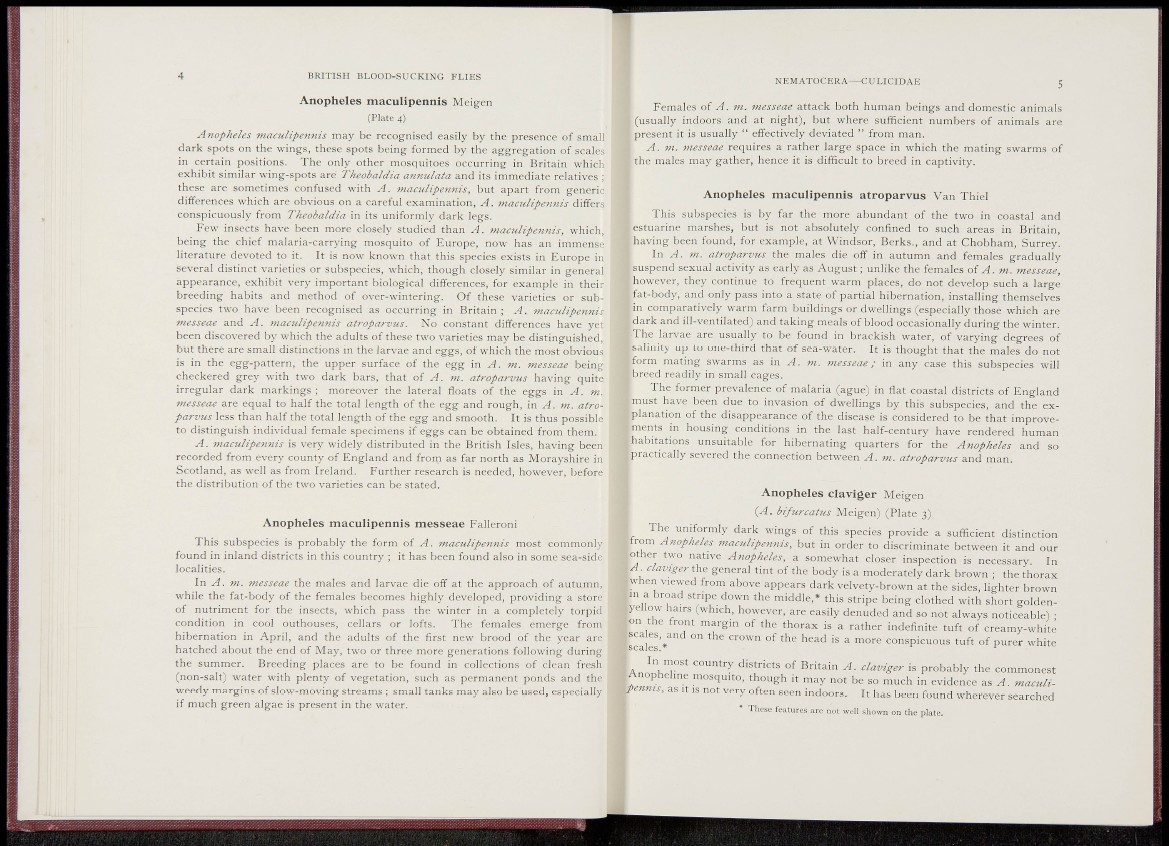
4 BRITISH BLOOD-SUCKING FLIES
Anopheles maculipennis Meigen
(Plate 4)
Anopheles ^naculipennis may be recognised easily by the presence of small
dark spots on the wings, these spots being formed by the aggregation of scales
in certain positions. The only other mosquitoes occurring in Britain which
exhibit similar wing-spots are Theobaldia annulata and its immediate relatives ;
these are sometimes confused with A. mandipennis, but apart from generic
differences which are obvious on a careful examination, A. ?naculipennis differs
conspicuously from Theobaldia in its uniformly dark legs.
Few insects have been more closely studied than A. maculipennis, which,
being the chief malaria-carrying mosquito of Europe, now has an immense
literature devoted to it. It is now known that this species exists in Europe in
several distinct varieties or subspecies, which, though closely similar in general
appearance, exhibit very important biological differences, for example in their
breeding habits and method of over-wintering. Of these varieties or subspecies
two have been recognised as occurring in Britain; A. maculipennis
messeae and A. ?naculipennis atroparvus. No constant differences have yet
been discovered by which the adults of these two varieties may be distinguished,
but there are small distinctions in the larvae and eggs, of which the most obvious
is in the egg-pattern, the upper surface of the egg in A. m. messeae being
checkered grey with two dark bars, that of A. m. atroparvus having quite
irregular dark markings; moreover the lateral floats of the eggs in A. m.
messeae are equal to half the total length of the egg and rough, in m. atroparvus
less than half the total length of the egg and smooth. It is thus possible
to distinguish individual female specimens if eggs can be obtained from them.
A. 7naculipennis is very widely distributed in the British Isles, having been
recorded from every county of England and from as far north as Morayshire in
Scotland, as well as from Ireland. Further research is needed, however, before
the distribution of the two varieties can be stated.
Anopheles maculipennis messeae Falleroni
This subspecies is probably the form of A. maculipennis most commonly
found in inland districts in this country ; it has been found also in some sea-side
localities.
In A. m. messeae the males and larvae die off at the approach of autumn,
while the fat-body of the females becomes highly developed, providing a store
of nutriment for the insects, which pass the winter in a completely torpid
condition in cool outhouses, cellars or lofts. The females emerge from
hibernation in April, and the adults of the first new brood of the year are
hatched about the end of May, two or three more generations following during
the summer. Breeding places are to be found in collections of clean fresh
(non-salt) water with plenty of vegetation, such as permanent ponds and the
weedy margins of slow-moving streams ; small tanks may also be used, especially
if much green algae is present in the water.
NEMATOCERA—CULICIDAE 5
Females of A. m. 7nesseae attack both human beings and domestic animals
(usually indoors and at night), but where sufficient numbers of animals are
present it is usually " effectively deviated " from man.
A. m. messeae requires a rather large space in which the mating swarms of
the males may gather, hence it is difficult to breed in captivity.
Anopheles maculipennis atroparvus Van Thiel
This subspecies is by far the more abundant of the two in coastal and
estuarine marshes, but is not absolutely confined to such areas in Britain,
having been found, for example, at Windsor, Berks., and at Chobham, Surrey.
In A. m. atroparvus the males die off in autumn and females gradually
suspend sexual activity as early as August ; unlike the females oi A.m. messeae,
however, they continue to frequent warm places, do not develop such a large
fat-body, and only pass into a state of partial hibernation, installing themselves
in comparatively warm farm buildings or dwellings (especially those which are
dark and ill-ventilated) and taking meals of blood occasionally during the winter.
The larvae are usually to be found in brackish water, of varying degrees of
salinity up to one-third that of sea-water. It is thought that the males do not
form mating swarms as in A. 7n. messeae; in any case this subspecies will
breed readily in small cages.
The former prevalence of malaria (ague) in flat coastal districts of England
must have been due to invasion of dwellings by this subspecies, and the explanation
of the disappearance of the disease is considered to be that improvements
in housing conditions in the last half-century have rendered human
habitations unsuitable for hibernating quarters for the Anopheles and so
practically severed the connection between A. m. atroparvus and man.
Anopheles claviger Meigen
{A. bifurcatus Meigen) (Plate 3)
The uniformly dark wings of this species provide a sufficient distinction
irom Anopheles maculipennis, but m order to discriminate between it and our
other two native Anopheles, a somewhat closer inspection is necessary In
A. claviger the general tint of the body is a moderately dark brown ; the thorax
when viewed from above appears dark velvety-brown at the sides, lighter brown
in a broad stripe down the middle,* this stripe being clothed with short goldenyellow
hairs (which, however, are easily denuded and so not always noticeable) •
on the front margin of the thorax is a rather indefinite tuft of creamy-white
i a l i "" conspicuous tuft of purer white
In most country districts of Britain claviger is probably the commonest
Anophehne mosquito, though it may not be so much in evidence as macuHpenms,
as it is not very often seen indoors. It has been found wherever searched
• These features arc not well showri on the plate.